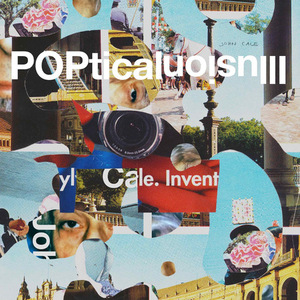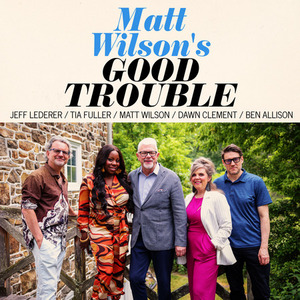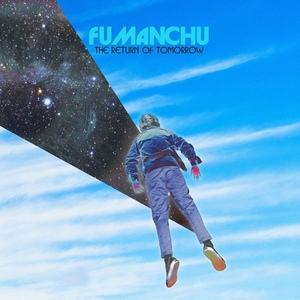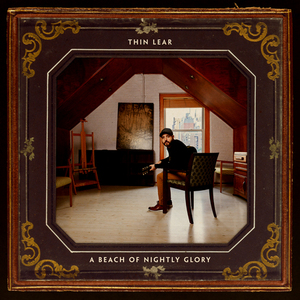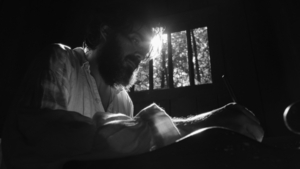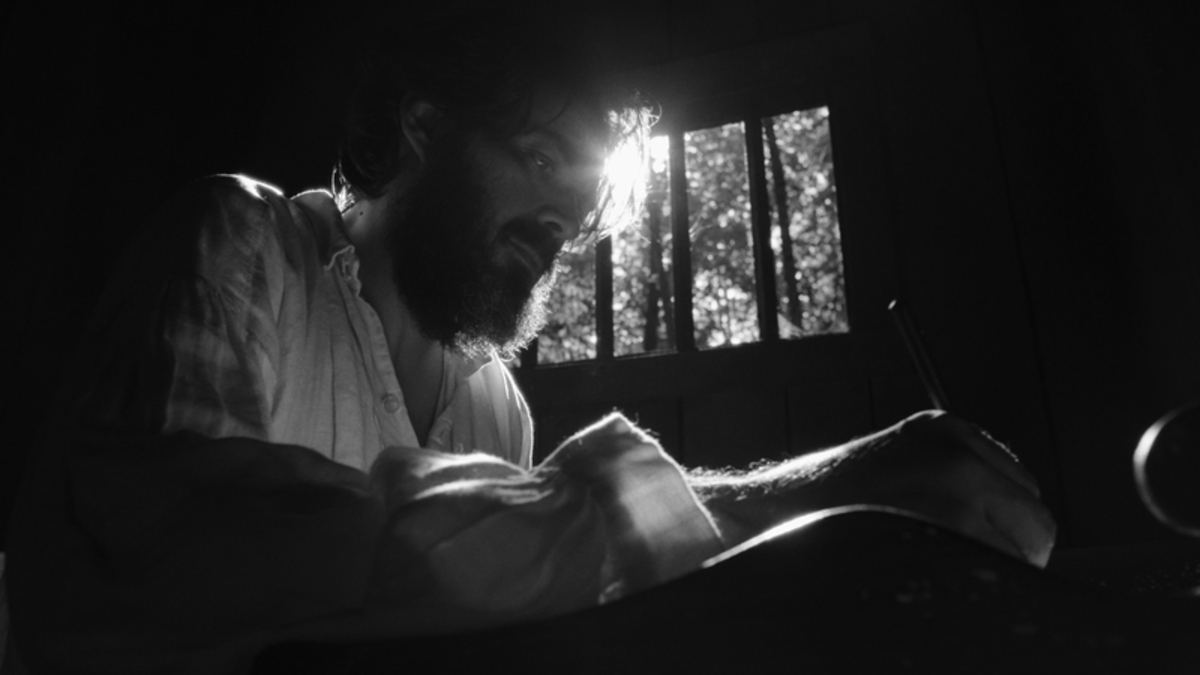
Matías Meyer
by Lily and Generoso Fierro
In the six years since we last spoke with Matías Meyer, the director has experienced a few landmark changes, personally and creatively. In 2019, he released Amores Modernos, which was an exploration into an ensemble cast and multi-threaded narrative contained primarily in the interiors of a family home, all of which were uncharted concepts in the director’s previous works of solitude in expansive environments. And, with his latest film, Louis Riel or Heaven Touches the Earth, which premieres at FICUNAM (Festival Internacional de Cine de la Universidad Nacional Autónoma de México) on Saturday, June 15, 2024, Meyer establishes his personal and professional base in Canada by meditating on the spiritual presence of one of Canada’s most notable and discussed historical figures, Louis Riel.
As a figure who came to symbolize the tensions in culture, language, and religion between the English and French settlers of Canada, Riel has been portrayed in books, films, and television, as well as in the heralded Chester Brown serialized comic and graphic novel, Louis Riel. Most accounts have been rooted in the historical facts of Riel’s life, tracing his beginnings to his execution, but Riel was a prolific writer throughout his life, and during his months in prison prior to his execution, his correspondences and writings were nearly entirely preserved, forming an incredible, direct view into Riel’s mind as he prepared to leave the Earth. These letters set the foundation of Meyer’s film, and the director, who also plays Riel himself, fuses his similar perspectives on nature and Catholicism with the words and thoughts of Riel to present an intimate portrayal of the soul of the man with a legacy and presence that stretches through Canadian history to today.
We were grateful to have the opportunity to speak with Matías Meyer again after all of these years. In our conversation, we discussed his everlasting interest in spirituality, how his life in Montreal has shaped his perspective as a filmmaker, his personal connections to the life and words of Louis Riel, and his grassroots, DIY production process.
• •
LF: In Wadley, Moros y Cristianos, and Los Últimos Cristeros, you approached spirituality in relation to its environment: many of your central figures travel through physical spaces to find God in some way. This has been a recurring theme in your work, and it is also present in Louis Riel. Did this consistent intellectual/philosophical interest ultimately compel you towards the story of Louis Riel?
MM: Thank you for presenting this question in these beautiful words, which I couldn’t synthesize in that way. After the retrospective of my films that I had at the UCLA Film and Television Archive in 2016, I realized that all of my films have confined characters, and my film on Louis Riel is very much that. It became so much more physical and even more obvious this time around. In my film, Yo, the central character is trapped in a childlike state, and in Los Últimos Cristeros, the characters are confined by nature, the mountains to be more specific, but in Louis Riel, my lead character is confined by an actual prison cell.
When I came to live in Montreal in 2011, I was very lost in the beginning — and I am still sometimes very lost here — about what I can identify with in this new country and culture. Louis Riel felt familiar to me because his story and words had all of these elements that you raise in your question. Riel has this spirituality, a mixed spirituality seen in my films, like in Los Últimos Cristeros where God is present in nature, in sunlight, in wind, and in the trees alongside the world of Catholicism, and Riel was that for me. He had these beautiful allegories about God and nature. Right now, I am reminded of the line when he says, and I am paraphrasing here, “I have thirty-two days to live, thirty-two hours, thirty-two seconds and how the wind, the chinook, is burning me.”
There is a scene in the film where I am shooting the leaves of a tree and the sun, and I incorporate a passage where he says, “The sun is trying to shine for everyone with the same intensity,” and he then circles that tree so that he can touch every branch. I find words like these so very beautiful. And, I identify with them because I come from a Catholic culture, but at the same time, my actual church is just life and nature. It is that mix that is appealing to me. I feel God when I walk in a natural setting or when I experience phenomena like the recent eclipse. It was magical. It is these relatable aspects of Riel’s perspective and beliefs that made me feel that I could do this film here in Montreal. As a Mexican filmmaker, I had become so accustomed to our culture and country, which is so full of things happening at the same time. There is the pre-Hispanic period, the colonial period, and the modern period — all of them are part of our everyday life, and there is such a mix of all of the colors, the smells, the races, and it is all so noisy. You just step out of your home, and you feel so alive. But here in Canada, you sometimes step outside and wonder where the people are. It is so big, and it can feel empty on occasion.
Beyond my personal interests and my adaptation to Canada, there is another element that attracted me to the story of Louis Riel. In one way or another, we all accept an inheritance from our parents. Since the age of twenty, my father has been very passionate about Louis Riel, and he transferred that passion to me.
GF: In your positioning of Louis Riel in a pastoral setting that further opens him up to direct communication with God, we find a similarity between him and Father Grandier in Ken Russell’s adaptation of Aldous Huxley’s The Devils of Loudun. Father Grandier is also considered a heretic, but receives his revelatory message from God while immersed in nature. From the conversations you include between Riel and Father André, we understand that Riel had proclaimed that he was a prophet, and from historical accounts, we understand that he had messianic callings throughout his life. How important was it to you to show Riel communicating with God in a different way from his past during his imprisonment? How much did the natural setting away from political structures and away from his home play a role in presenting this shift as Riel prepares for death (and Heaven)?
MM: I don’t think that it was fully conceived in the script. It developed organically through location scouting. I was looking for a prison, and luckily, I found this location only one hour from Montreal called Canadiana Village that used to be an open-air museum, but after many years in existence, it began to fall apart. However, about five years ago, a young French man purchased the place and attempted to restore it in order to make it into a new glamping destination. In its current state, it is very much like an old Western town where you can actually go inside of the houses that are there, and these places are furnished. When I visited the place, they had just finished filming a television series. And, by chance, for that series, they had to build a prison, which became the one you see in my film. The prison was in the middle of nature, and I fell in love with it because it was a kind of oasis. The man who owned the village agreed to rent me a couple of the properties there: the prison and the other building where the interview with the journalist is conducted. It all arrived so magically.
In the beginning, I wanted to shoot in Manitoba, not only because of Riel’s legacy there, but also because part of the title, Heaven Touches the Earth, refers to the plains of the region, where there is just a thin line that divides the sky from the earth. But, given that I didn’t have a large budget, I couldn’t afford to move the production there, and so I decided to let go of certain factual elements of Riel’s life in favor of capturing his essence. For example, Riel’s execution occurred on November 16 in Regina, but in my film, it’s clearly not cold when it happens, and the leaves are still on the trees because it was thirty degrees Celsius when we filmed the scene. I didn’t worry about the accuracy of these kinds of specifics, because Riel’s essence is more about how he feels and the words he said than the exact minutiae he experienced. In my film, Riel has a view from his prison cell, but in reality, I’m not sure that he had a view. But, I wanted to show him seeing the trees outside and how they vertically blend with the bars on his windows, and depending on how the focus on the camera was adjusted, you are not sure if you are seeing trees or the bars. Also, on this site, I could go outside, and there were these fields where I shot the scene with my daughter, who portrays Riel’s son in the film. There was this lovely ambiance with nature in this location — it was all un coup de chance, but it ended up being so inspiring.
This happenstance is present in some of my other films as well. In Los Últimos Cristeros, we were scouting, and we discovered this cave. During sunset, the cave had this effect that led to a shot that you may remember: when all of the Cristeros are sleeping and the sun slowly sets, it casts shadows on the walls, giving a feeling that the presence of God was in that place and that He was with them.
LF: Based on what you’ve described so far, it sounds like Riel’s writings always involve this element of poetry and nature, and the location brought out that poetry in an unexpected but meaningful way. It’s amazing that this setting in and around Canadiana Village was the element that clarified the essence that you were trying to capture.
MM: Maybe if I had had some more time or patience I could have waited for the winter, which I’m sure would’ve also been very beautiful too. In the poem that he wrote for Robert Gordon [the prison guard], Riel speaks about the snow and how the ground is all white from when heaven comes here. He saw the symbolism of white as representing purity. I also read that what he asked for as his last meal was what you see in my film: a glass of milk and some hard boiled eggs. Of course, eggs are a Catholic symbol, but he is also trying to arrive at the moment of his death with his soul as pure as possible.
LF: In your research into Riel’s writings from prison, did you see evidence of an abandonment of his beliefs that were considered heretical by the Catholic church? Did he still consider himself as a messianic figure during this time?
MM: Indeed, he did. In the first page of his book, Massinahican, which means “the book” or “the Bible” in Cree, and in his journals, he declared that he was a medium of God. Thus, this was a particularly important aspect to consider when writing and editing the moment when Riel signed the document that rejected the notion of his prophetic nature as a means to be allowed back into the Church. Of course, that signature made me think of Joan of Arc, as depicted in the films of Carl Theodor Dreyer and Robert Bresson, when she is spared execution if she signs a document rejecting her claims. She signs the paper, but then she repents because it would be like claiming that all that had happened to her was a lie.
I wondered if I should have used this moment of Riel’s concession as a dramatic narrative element of my story, but I ultimately made the decision that it wasn’t so important. I think that Riel signed it as a way of convenience because he really needed the Catholic Church to be with him. He needed the healing of a priest, but at the same time, his calling was stronger than him. It wasn’t that he signed the paper and then believed that he wasn’t a prophet anymore. I don’t know what this morally means overall, but for me, he just signed the paper and continued to write his prophecies. As a spectator, do you feel disappointed by that? For me, I don’t care that he signed this paper that asserted that he was not a prophet of the new world.
GF: Louis Riel or Heaven Touches The Earth explains at the beginning that the letters and writings from the period of Louis Riel’s imprisonment were nearly completely preserved, thus establishing the setting and focus of your film. Did you consider including any of Riel’s earlier correspondences and writings to provide a contrast to his state of being, such as the letters to and from Gabriel Dumont, who ultimately convinced Riel to leave the life he created in Montana to return to Saskatchewan, or his religious discourses around the time of his asylum stay while he was in exile in Quebec?
MM: The process of writing was pretty complex, and at some point I made the choice to take a pure and minimalist approach. That decision cut any possibilities of using flashbacks to look at different periods of his life. I have versions of the script that involve the Battle of Batoche and the time when Riel fought his attorneys when they wanted him to take an insanity plea, which he firmly rejected. About the latter incident, he wrote an amazing sentence to the effect of, “If I admit that I am insane, I would be negating my intellect and my humanity, and thus I would become like any other animal.” Regardless, his lawyers asked the judge to forbid Riel from speaking during the trial. He was allowed to speak only at the end of the proceedings, and at that point, he gave a long statement.
Dramatically, I found it interesting that he was fighting his own lawyers because they weren’t defending what he wanted to defend. Riel, in fact, wanted this process to be a moment of truth that exposed all of the crimes that were committed by the government of Canada against the Métis people. I also had written a scene around the moment when Riel surrendered. In the moments before he did, he took off his shoes and walked through the snow to the generals. But, in the end, I omitted these scenes outside of his period of imprisonment.
I feel that the linearity of the way that the film was put together works dramatically in that he moves little by little towards an end that you know is inevitable. This goes against the classic narrative convention where you want to surprise the audience by the ending. You know instinctively by the tone of the film (alongside the historical facts of the subject) that Riel is going to die. The structure is similar to another film by Bresson, A Man Escaped. From the beginning of Bresson’s film, you know what is going to happen at the end, but I like this constraint because you can still build so much on top of that.
I have a friend, a photographer who worked on my earlier films, who asked me to shoot a scene where you see Riel in a state of fury or possession because we know that he had these moments of rage throughout his life. My friend wanted a scene of an enraged Riel as a means of contrast for how we eventually see him in my film, but I didn’t want to do that.
LF: I agree that excluding such an impassioned scene was a good thing because it would have disrupted the tone you constructed. Your film, as it stands, is an extended sequence of meditation up to a very intense and dramatic event. There are also so many accounts of Riel’s more wild moments, so it is good to see this other side of him, whether it is entirely real or done to capture some essence of who he was. One of the things that impressed us immediately after seeing your film was the discipline of tone and the discipline of minimalism. That kind of impassioned scene would take so much away from that.
MM: Yes, it is true that it is difficult to mix tones like that, and what you are saying reminds me of the first page of my father’s book on Louis Riel. He wrote that in his cell, Riel is finally calm. The war, the travels, the persecution, and all of the paranoia has been left behind, and now he can rest and write. It’s strange that the first two or three pages of my father’s book cover my entire film. Riel will be in his prison cell, and he will be at peace. He did what he needed to do, and he surrendered. He created a process where he evidenced all of the bad things that the Canadian government had perpetrated against the Métis. He surrendered because Macdonald wanted Riel, and if he hadn’t given himself up, Macdonald and his officials would’ve continued to go after his people instead.
So yes, he did what he needed to do ever since he began the first movement in 1870, and the many years that followed were very stressful for him. Being a political leader every day was never his ambition. He became a leader because he was so well educated. Riel’s most formative and rigorous years of education started in Montreal when he was around thirteen, and he came back when he was almost twenty five years old to Winnipeg — though of course, it wasn’t called that then — to help his mother because his father had passed away. When he returned, he brought back his learnings from his education as well as the experiences of working at a law firm and a newspaper.
When he arrived at his village, he saw the colonizers coming and surveyors sent by the government, and that was the moment that changed his life. A cousin of Riel’s told him that these people were surveying our land, and Riel responded by going to them, putting his foot down on their Gunter’s chain, and telling these surveyors to get out of their land. From this moment on through the next fifteen years, Riel had so many adventures: becoming the leader of his people, defending their rights, going into exile in the United States, filling himself up with paranoia and ending up in an asylum, getting married, and having some peace while teaching children. But then, he was again called back to his village to defend the rights of the people there. Thus, while awaiting execution in his cell, Riel finally had the time and peace to ponder his spirituality.
GF: We know that you’ve wanted to make this film for years, and we were fascinated to see you performing as Riel himself because you have not acted in your feature films. Was your decision to play Riel based on your proximity to all of the research? What aspect of Louis Riel’s prison correspondence did you key in on while preparing yourself for the titular role?
MM: To be candid, I didn’t need extra preparation for the role. I was prepared by the entire process of writing the script so many times — wanting to not do the film anymore and then coming back to it. I knew that I needed a very good actor to play Riel, but no one would be as passionate about this character as I was because I had been working on this project for so many years, and I had been feeling it so deeply and suffered through a lot of rejection through the process: not finding any producers, not finding any money, and coming to Canada and having to begin all over again here. I made five feature films in Mexico, but they didn’t amount to anything here in Canada, and I had to start from ground zero. I accepted all of this and approached it as I did with my feature, Wadley: I’m going to do this by myself, with no money, and I don’t care.
I also felt like I was incarnating the character in some way — not just lending the film my abilities as a director, writer, and producer, but also giving it my own flesh. I felt this would make the film stronger. Also, I felt that the film was a reflection of my time in Canada and the many years that I spent in this country feeling isolated.
Most of the other people you see in the film are friends of mine whom I met here. None of them are professional actors. Almost everyone is part of my life here in Canada. In the eerie scene — which I love because it’s both erotic and frightening — where a voice of the dead says, “When everyone leaves I will stay here with you because I love you, I want you, and I desire you,” that voice is the voice of my wife Roxanne. My daughter Alina, as I mentioned earlier, plays Riel’s son in the film, and adding to all of this, at that time I had a health issue that has thankfully been resolved.
During the pandemic, I used to travel to the mountains, but I began to have some chest pains, and when the pandemic was over, I went to the doctor and told her about the pains. My doctor took x-rays of my chest, and a few days after that, she asked me to come into the office because she saw something that concerned her. Then, she ordered a CT scan, which caused me great concern. The scan took place during Canada Day, and so I had to wait five days for the results. I remember being on the terrace one day during that waiting period, and Alina entered, and upon seeing her I was so sad. In the end, it turned out to be nothing bad, just a scar that I had for some time, but then they discovered that I had asthma and had been living with it for almost twenty years without knowing.
It was at that period that I decided that I was going to portray Riel because I felt like I was a condemned man (laughs). It all turned out fine, but I felt so close to the character. There were also some very mysterious moments that happened during shooting whenever I was left alone. For example, in the early scene when the priest visits him and says something like, “If you don’t sign this paper, the Church is not going to commute you,” and the priest leaves the room, and I am left alone there. I began to cry at that moment, and that reaction was not scripted or planned. The priest left. I was alone, and it happened. Whenever people would leave the cell, such as when the journalist leaves me alone in the end, these reactions would occur. I wasn’t looking for them. They just happened. That was interesting to me.
Finally, I wanted to leave this film as a portrait for my children, an image of who their father was at this age. Oddly, I was forty-two when I made this film, and Riel was forty-one when he died. I could also speak in French and in English. Many things were in place to connect my person and being to the spirit of Louis Riel. ◼
Featured photo courtesy of La Distributrice de films.
Louis Riel or Heaven Touches the Earth • FICUNAM • Matías Meyer





